E-learning is becoming increasingly popular and is already being used successfully in many companies. We understand e-learning as learning supported by digital media. This can be, for example, web-based training, a video course, or an online webinar.
Contents:
The global e-learning market is expected to be worth $325 billion by 2025.
The turnover of the e-learning industry in the US and Europe is growing from year to year. Even during the financial crisis of 2007, growth continued. Right now, the e-learning sector is also experiencing an all-time high. Almost any entrepreneur who wants to scale their personal brand simply has to inspect such services. This is a great opportunity to share information and experience in their field. Everyone dreams of finding a new way to monetize their expertise. Online education platforms are one of the most advanced opportunities to do so.
If you are just about to create your e-learning website, find answers to these 6 questions:
What is the goal of your e-learning platform?
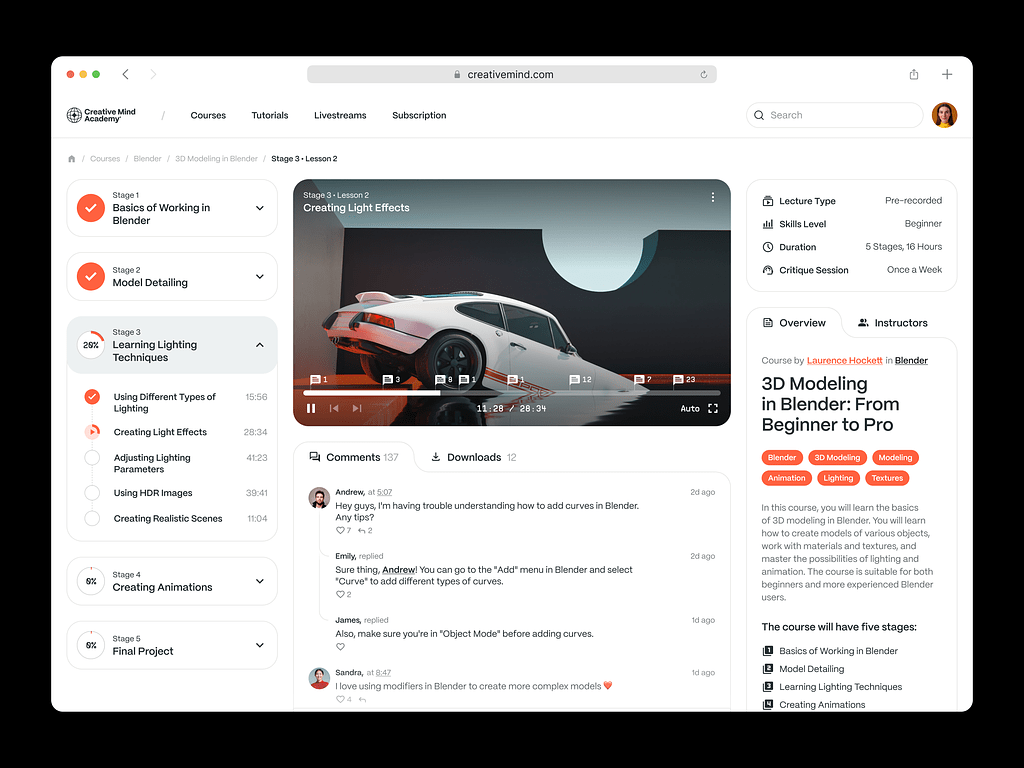
Online Courses Platform Website by Shakuro
What should the participants learn in the online course, seminar, or during training? With what result do they complete the education on your platform?
Creating your e-learning courses will only be as productive as your planning beforehand. By taking the time to do some preparatory work, you address problems before they can arise.
Summarize all the results from the brainstorming session in a catalog of requirements and expectations. Because you can only develop it successfully if you know what your e-learning platform offers.
“Brainstorming is the nexus of ideas.” — Asa Don Brown
Creating an e-learning course that teaches everything to everyone is a wasted effort. It must be created with a specific purpose and for a specific audience. Before you develop an e-learning platform, inspect your potential trainees.
- How many learners can take part in a course at the same time? Is it a massive online open course?
- What is the position/role of the trainees? Are they sales representatives, customer service representatives, or HR managers?
- Are there trainees with disabilities that will need more human-centered design?
- What are the demographics and characteristics of participants in e-learning? (average age, level of education, geographic location, computer skills, devices used by learners, etc.)
- Have the learners of the e-learning been previously trained in this subject area? How well do you know the topic?
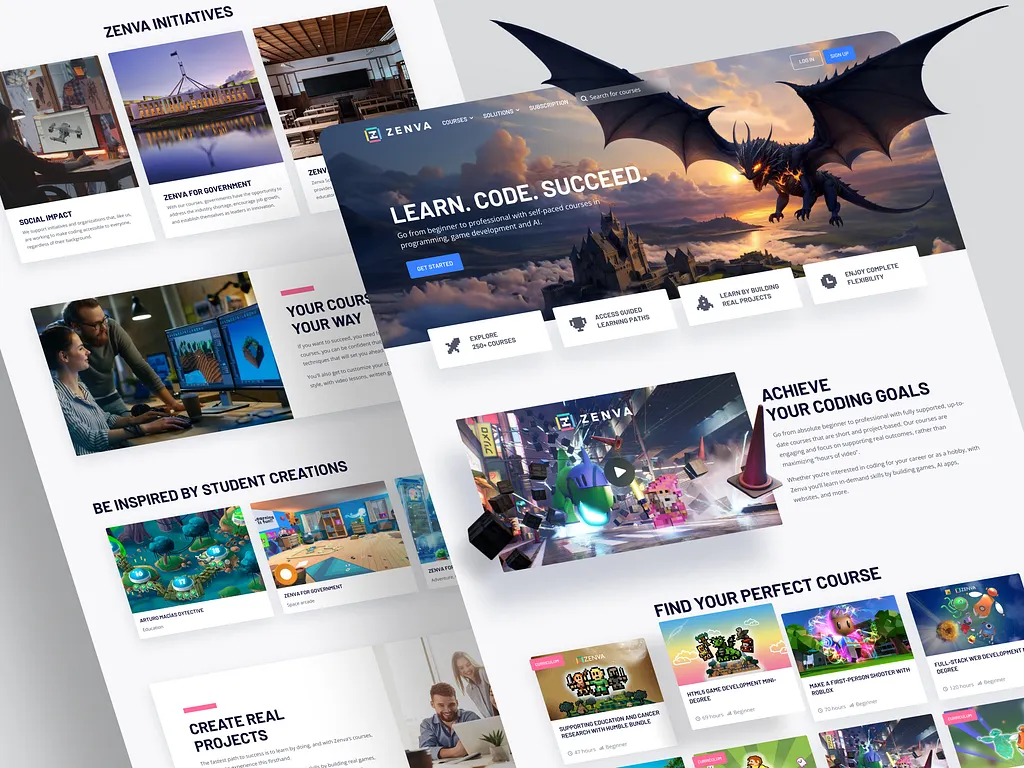
Zenva Academy Website by Shakuro
Where is your e-learning platform going to be based?
The next thing to think about is how to make your e-learning course accessible to the audience. The easiest and most convenient way to manage the training process and your e-learning online is by using a digital e-learning platform.
Many businesses need a website, but when it comes to creating one, the big question is cost. It can be very expensive to recruit and pay for an in-house web development team. Therefore, outsourcing web design and website development to a third party can be an attractive and cost-effective solution.
The cost of website outsourcing usually depends on 3 different factors that affect the way a designer or programmer works:
- the complexity of the design
- website functionality
- total number of pages on the site
- illustrations
You can learn more about how website costs form in our article or try to estimate the cost by yourself with the help of our project cost calculator.
E-learning platform for a startup

E-learning Education Web Platform by Conceptzilla
A startup company may choose to build its e-learning website with a CMS like WordPress. This platform is suitable for the most common and popular types of web resources, including the following:
- online stores
- small promotional pages
- landing pages
- galleries
- personal websites
- educational resources
71% of small businesses have their own website.
Unfortunately, one third of startups make it to the 10-year mark, with every fifth failing during the first year. Why do startups fail and how to prevent it? Here is an article about it.
E-learning platform for a growing company
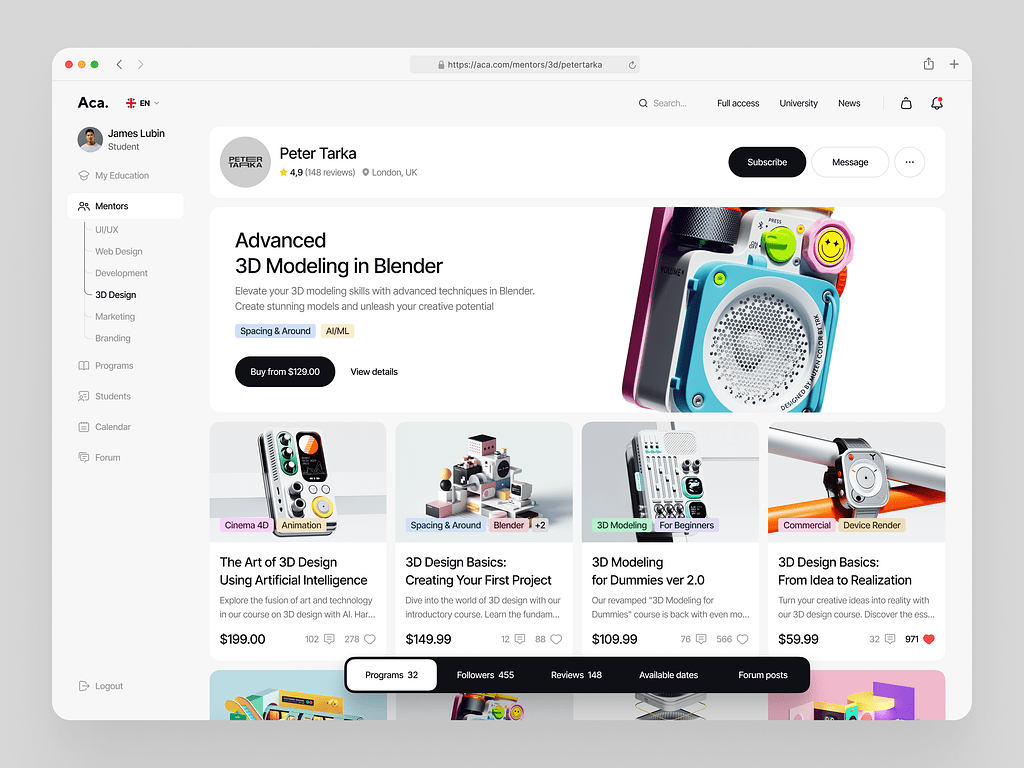
Online Courses Platform Website Dashboard by Shakuro
Businesses expand and need more and more custom functions, so an old web platform may become difficult to support and maintain. Here is an example of one of our clients, CG Master Academy, an e-learning company that faced the problem of not being able to implement new features and manage bugs on an aging site.
The previous version of the website, an open-source CMS, was getting on in years and no longer served this purpose satisfactorily. In addition, the website was not responsive.
During our work on CGMA, we focused on these aspects of their new platform:
- New engaging design
- Data migration to a new platform
- Introducing new features to a new platform
Since we work according to the principle of user-centered design, the focus with CGMA was on the user – in every phase of the project. A principle of user-centered design is to reimagine the platform that you’re working on as you are its user. This is why during our research we came up with an idea of how not only to better the design of the project but also how to develop a new navigation system.
Another of our clients, Proko, started out as a small one-man company that fully operated on a WordPress platform.
One of the most interesting challenges in this case study was not only to build a new site but to literally spread its influence to new countries like China. Because Youtube, Google, and many other services are banned in China, our developers had to find new ways of how to make Proko more accessible in that country.
You can learn more about e-learning projects that we’ve worked with on our “Works” page.

Skillhouse Elearning Platform by Shakuro
E-learning marketplace like Udemy
Creating a course marketplace can provide you with a variety of benefits. Firstly, it can help you expand your reach and tap into new spheres. You can attract a new target audience and provide value to your existing customers. Secondly, online learning tools can be a great way to monetize your expertise. If you are an expert in a particular field, you can create courses and content that others are willing to pay for. Finally, it can provide passive income. Once created, this business can continue to generate revenue without huge additional effort.
Now, why Udemy? It is one of the most popular e-learning platforms that offers a wide variety of courses on various topics, including business, technology, and personal development. There are several reasons why it has become so widespread:
- Large course selection: it offers lots of courses, with over 213,000 of them available as of 2023. People can choose from a broad range of topics, from programming and web development to marketing and UI/UX design.
- User-friendly platform: elegant course delivery makes it easy for learners to navigate and find the topic they need. The website is well-designed, with clear descriptions, ratings, and reviews, so the users can make informed decisions about which deals to take.
- Affordable pricing: Udemy’s pricing is also a factor in its popularity. Many courses are available at a very affordable price point, which makes them accessible to a broader range of people. Additionally, the company often runs promotions and discounts, further increasing its affordability.
- High-quality instructors: experienced and knowledgeable instructors create and teach educational resources. The platform provides an opportunity for anyone with expertise in a particular subject to share their knowledge and monetize their skills.
- Certification: Udemy offers certification for many of its courses, which can add value to a learner’s resume and career prospects. This makes it an attractive option for professionals looking to upskill or reskill in their careers.
| Pros | Cons |
|
|
There are other platforms you can take into account as well, for example:
Coursera
Coursera is one of the world’s largest online learning platforms, with millions of students and partnerships with over 200 top universities and companies to produce the best courses in a wide range of subjects.
| Pros | Cons |
|
|
Pluralsight
If you are an IT professional or want to work in this field, Pluralsight is the best platform for you. It provides video-training sessions to a variety of professionals from various industries, including IT administrators, software engineers, and many others.
| Pros | Cons |
|
|
Sololearn
SoloLearn is a programming language learning app that is available on multiple platforms. Over 22 million learners worldwide use the SoloLearn apps to improve their programming and coding skills. SoloLearn offers a wide range of courses, such as C++ coding, Python code, Java programming, HTML Fundamentals tutorial, CSS Fundamentals tutorial, and so on.
| Pros | Cons |
|
|
Programming hub
Programming Hub is an app with a massive course library that includes machine learning, Android, and iOS app development, not to mention languages like Python, HTML, C++, and many others. The platform has received over 108,000 reviews on the Google Play Store and 3.6k+ ratings on the iOS App Store, with a 4.7/5 star rating.
| Pros | Cons |
|
|
Udacity
The platform is modeled after the “coding bootcamp” learning style, with programs focusing on web development, programming, cloud computing, and data science. Whether you’re a complete beginner looking to learn a new skill or an experienced learner looking to broaden your knowledge of a particular subject, there’s probably a course at the appropriate level for you.
| Pros | Cons |
|
|
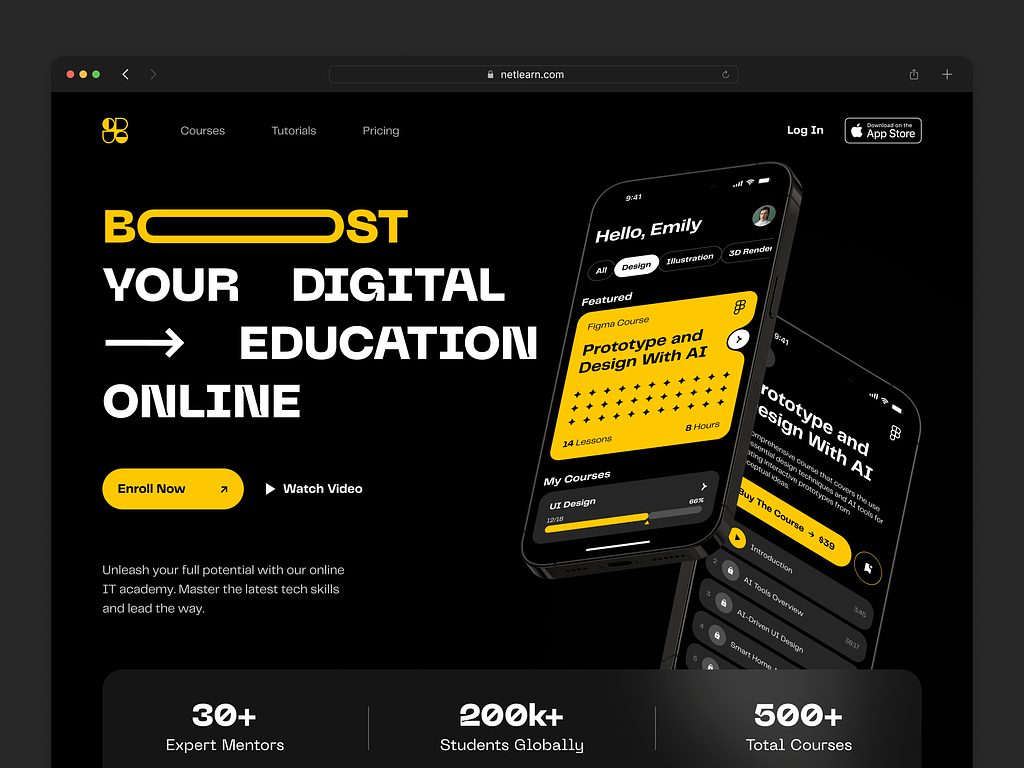
Online Education Website UI UX Design by Shakuro
Building your educational platform
Just like with any other project, you need to create a detailed business plan first.
Define your target audience
The first step in creating an e-learning platform is to define your target audience. Who are the people that will be using your platform? What are their needs and interests?
Set up a budget
Creating an e-learning platform requires investment. You will need money for web development, course creation, marketing, and support. Set a budget that is realistic for your business and stick to it. If you want to know approximate numbers, you can use special tools for calculating app design costs. With their help, you can discover how many resources are required for design, development, branding, etc. Decide how you will make money from your virtual classroom. Udemy and other online learning tools have adopted a freemium model, where users can access some content for free and pay for premium content.
On the whole, the most profitable monetization models for e-learning apps are:
- Subscription
- Freemium
- Course fee
- In-app ads
- In-app purchases
- Paid installs
Choose a time-proven provider
The first step in creating e-learning software is to choose a platform provider. There are many options available, including learning management systems (LMS) like Moodle, and course marketplace platforms. Consider the features, cost, and scalability of each option before making a decision.
Select essential services and features
Once you have chosen the provider, consider the services and features that people would like to see in your product. Divide options into essential and non-essential, so you know what things you need to concentrate on more. The features may include a virtual classroom, course creation tools, assessments, rewards, and analytics.
Design the educational resources
Design your e-learning platform to be user-friendly and visually appealing. Use a consistent design language throughout the platform, and make sure it is optimized for mobile devices.
Adding engaging and interactive content
Neat programming code is just halfway. To attract and retain users, you have to offer high-quality online course content that shows positive results and is interesting to take. Create a structure that is clear and easy to follow. Divide your courses into modules with increasing difficulty and include small tests along the way to help learners gauge their progress.
Incorporate assessments
Assessments are an important part of online learning. They help students test their knowledge and reinforce concepts. Consider including quizzes, exams, and assignments to test people’s understanding of the material and see the weak spots.
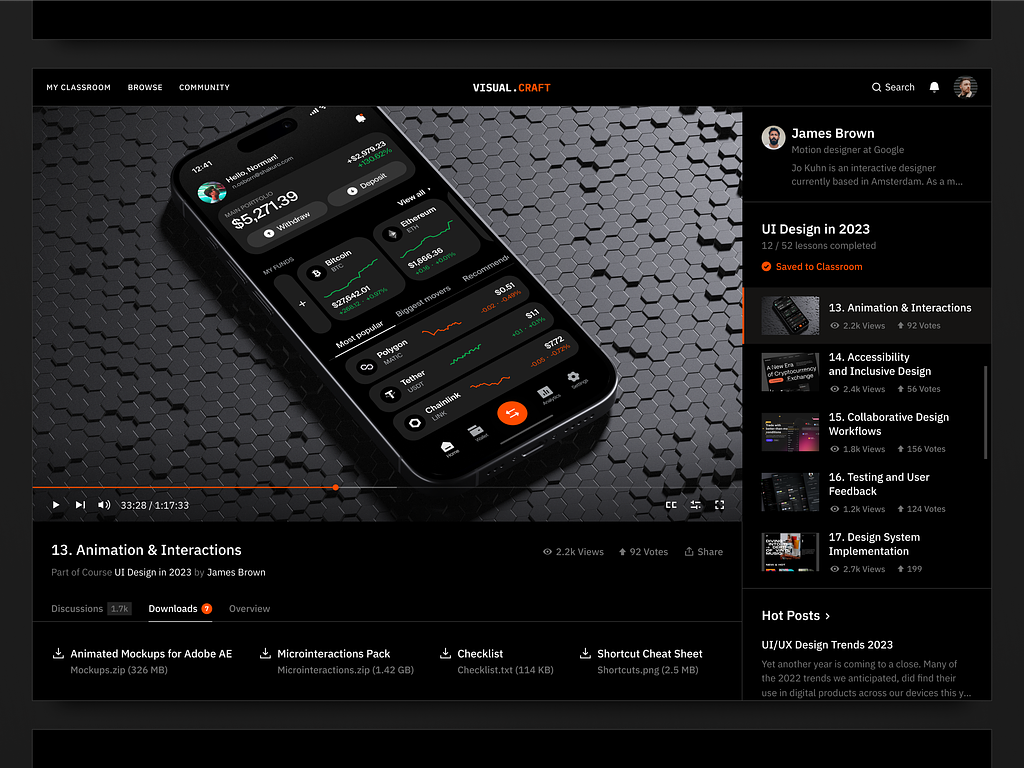
Online Education Website Design by Shakuro
Tips on e-learning app development
- Make learning active, intuitive, engaging, and meaningful: Active learning means that students purposefully take part in the learning process, engage in it, performing better as a result. Intuitive design is a cornerstone—every user should be able to easily interact with the system. Meaningful learning means that at every step students are aware of exactly why they study this or that subject and what they are going to get as a result.
- Use real teaching methods: Perform project-based and problem-based learning, as they are far more rewarding than a simple consumption of facts. Facilitate cooperation among students because working in a group improves the attention, involvement, and acquisition of knowledge. As a contemporary approach, try gamification for some competitive and challenging aspects.
- Add personalization: The content or curriculum that is tailor-made to users’ needs is one of the features that can attract and engage people to your app.
- Introduce only necessary functions: It’s better to avoid adding trending or extra functions and technologies just for the sake of it. Otherwise, a user may become overwhelmed with options, get tired, and not achieve their goals, which means that your app will come flat, failing to serve a purpose.
- Provide social network elements: You can either incorporate your own social elements in your app’s design or integrate them with the existing social networks.
- Focus on KPIs: It’s very easy for educational app developers to lose track of indicators that matter in pursuit of a higher number of users. What matters is how many of them bring profit (depending on your monetization strategy).
Conclusion
No doubt that creating an e-learning platform like Udemy is hard, but it’s a great way to diversify your business and provide value to your customers. By following the steps outlined in this article, you can build a product that provides a great learning experience and generates revenue for your company. Don’t be daunted by the challenges: remember to focus on your target audience, create engaging content, and promote your platform to reach a wider audience. With the right strategy and execution, your online courses can become a valuable asset to your business.
Do you want to build your own web platform? Contact us and we will create a high-quality service that provides everything your audience needs.
